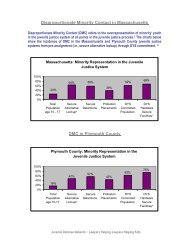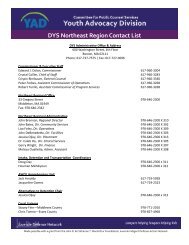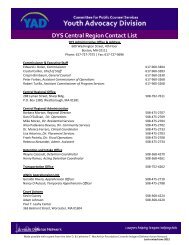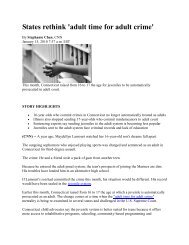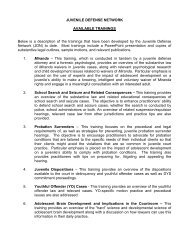Adolescent Brain Development - the Youth Advocacy Division
Adolescent Brain Development - the Youth Advocacy Division
Adolescent Brain Development - the Youth Advocacy Division
Create successful ePaper yourself
Turn your PDF publications into a flip-book with our unique Google optimized e-Paper software.
SCOTT, ELIZABETH, J.D.<br />
Professor – University of Virginia Law School<br />
Phone: (434) 924-3217 Fax: (804) 924-7536 Email: es@virginia.edu<br />
Website: http://www.law.virginia.edu/lawweb/faculty.nsf/FHPbI/5417<br />
Co-director and founder of <strong>the</strong> Center for Children, Families and Law and law professor at University of<br />
Virginia who specializes in juvenile and family law. Author of “Blaming <strong>Youth</strong>,” (2002), an essay which<br />
uses scientific research to demonstrate why juveniles are not as culpable from a legal perspective.<br />
SOWELL, ELIZABETH, Ph.D.<br />
Professor – UCLA Medical School, Neurology Dept.<br />
Phone: (310) 206-2101 Fax: Email: esowell@loni.ucla.edu<br />
Website: http://www.neurology.ucla.edu/faculty/SowellE.htm<br />
Led studies of brain development from adolescence to adulthood. Found that during adolescence, <strong>the</strong><br />
frontal lobe of <strong>the</strong> brain (<strong>the</strong> part that relates to <strong>the</strong> maturation of cognitive processing and o<strong>the</strong>r<br />
‘executive functions), undergoes <strong>the</strong> most significant changes. The study found that <strong>the</strong> frontal lobe was<br />
<strong>the</strong> last part of <strong>the</strong> brain to fully develop, and thus while adolescent brains may be similar to adults, <strong>the</strong>y<br />
differ in <strong>the</strong>ir abilities to reason.<br />
TOGA, ARTHUR, Ph.D.<br />
Professor – UCLA Medical School, Neurology Dept.<br />
Phone: (310)206-2101 Fax: (310)206-5518 Email: toga@loni.ucla.edu<br />
Website: http://www.neurology.ucla.edu/faculty/TogaA.htm<br />
Neuroimaging specialist who worked with NIMH to render MRI scans into a 4-D time-lapse model<br />
demonstrating <strong>the</strong> evolution of a child’s brain into adulthood (<strong>the</strong> 4 th dimension is rate of change). The<br />
model demonstrates <strong>the</strong> growth and movement of different brain matter as children grow into adults.<br />
YURGELUN-TODD, DEBORAH Ph.D.<br />
Neuropsychologist – McLean Hospital, Belmont, MA<br />
Phone: (617)-855-3238<br />
Website:<br />
Fax: Email:<br />
Performed a study comparing what parts of <strong>the</strong> brain adolescents and adults use when responding to<br />
emotions. The study concluded that adolescents tend to rely on <strong>the</strong> part of <strong>the</strong> brain responsible for “gut<br />
reactions,” in contrast to adults who more often use <strong>the</strong> part of <strong>the</strong> brain responsible for more rational (not<br />
based on emotional responses) decisions.





